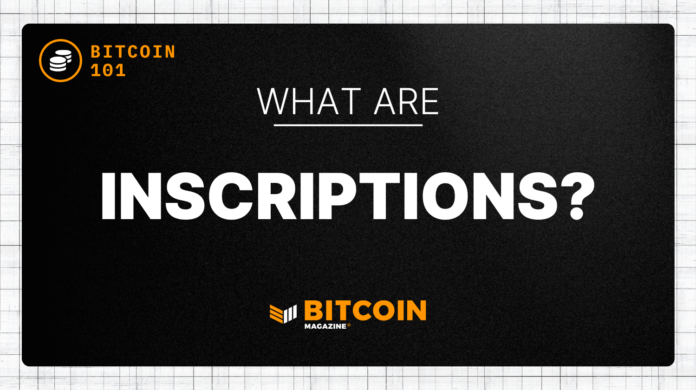Inscriptions are a novel feature that allows users to permanently store data, such as text, images, or even files directly on the Bitcoin blockchain. Introduced through the Ordinals protocol by developer Casey Rodarmor in January 2023, inscriptions offer a way to create immutable records of digital artifacts on Bitcoin’s most secure and decentralized network. Unlike NFTs, which rely on separate tokens or additional layers on other blockchains, inscriptions live directly on Bitcoin’s main layer, making them a native part of its structure.
Understanding Inscriptions
To understand inscriptions it helps to know how they relate to Ordinals, the system that made them possible. Ordinals is a numbering scheme developed to track individual satoshis—the smallest unit of bitcoin, equal to 0.00000001 BTC. Through this system, each satoshi can be uniquely identified and, in a sense, personalized. Once the Ordinals protocol was in place, it became possible to inscribe data onto these numbered satoshis. This data could be anything from a simple text message to an image, turning a satoshi into a carrier of information.
In essence, an inscription is data embedded in a Bitcoin transaction. The data is permanently linked to the inscribed satoshi and can be viewed by anyone with access to the blockchain. Importantly, inscriptions are immutable, meaning once they are added to the blockchain, they cannot be changed or removed. This permanence aligns with Bitcoin’s fundamental properties — security, decentralization, and immutability.
The Technology Behind Inscriptions
The key technological change that enabled inscriptions on Bitcoin was a Bitcoin Improvement Proposal (BIP-141), which introduced Segregated Witness (SegWit) in 2017. SegWit increased Bitcoin’s block size limit by separating transaction signatures from transaction data, allowing more data to fit within each block. A subsequent update, Taproot (BIP 340), which activated in 2021, further improved Bitcoin’s efficiency and privacy, indirectly facilitating the Ordinals protocol and inscriptions.
With Taproot, the way signatures are handled became more efficient, allowing more flexibility in the kinds of data that could be included in Bitcoin transactions. These technical improvements made it feasible to embed additional, nonfinancial data — like inscriptions — within Bitcoin transactions, without bloating the blockchain excessively or compromising its security.
How Inscriptions Work
Inscriptions work by embedding data in the witness portion of a Bitcoin transaction. This data is attached to a satoshi tracked by the Ordinals protocol, and once the transaction is included in a block by a miner, the inscription becomes a permanent part of the blockchain. Since inscriptions rely on Bitcoin’s base layer, they benefit from Bitcoin’s decentralized and secure infrastructure, ensuring the data is stored forever. Unlike NFTs on other blockchains, where the actual data is often stored off-chain, Bitcoin inscriptions store the data directly on-chain.
Learn More >> Bitcoin Explained: Inscriptions
Use Cases for Inscriptions
One prominent use case for inscriptions is digital art. Artists can create and share digital artworks that are inscribed directly onto the Bitcoin blockchain, offering the same level of security and permanence as the network itself. This differs from NFTs which typically rely on secondary layers or external storage systems.
Inscriptions can also be used for important document storage. The Spartacus Project is one such example, whereby the Wikileaks cables were inscribed permanently on the Bitcoin blockchain. Since inscriptions are immutable, they provide a reliable way to store critical information, such as proof of ownership, time-stamped messages, or other data that needs permanent preservation. This use case leverages the durability of the Bitcoin blockchain to ensure that the information is safely stored and accessible for the long term.
The Limitations of Inscriptions
While inscriptions offer an interesting new way to store digital artifacts on Bitcoin, there are limitations to consider. Bitcoin blocks have a maximum size limit (currently around 4 MB with SegWit), which restricts how much data can be included in each inscription. This means that inscriptions are better suited for relatively small files — like simple images or brief text messages — rather than large multimedia files.
Additionally, inscribing data onto Bitcoin’s blockchain requires a Bitcoin transaction, which incurs fees. The larger the data being inscribed, the higher the fees can become, which could limit the scalability of inscriptions for certain use cases.
The Future of Inscriptions
The introduction of inscriptions has opened the door for new ways to interact with Bitcoin beyond its primary use case as a store of value and medium of exchange. While inscriptions are still in their early stages, they showcase the flexibility and adaptability of Bitcoin as a protocol. They also help push the boundaries of our understanding of the nature of a monetary network.
Inscriptions do raise questions about the long-term impact on Bitcoin’s blockspace and whether such use cases align with Bitcoin’s core philosophy of providing sound money. There is a valid concern that inscriptions could lead to bloating the blockchain, increasing costs for those using Bitcoin for financial transactions. It could also be a natural evolution of Bitcoin’s capabilities.
Conclusion
By allowing users to embed data directly onto the blockchain, inscriptions provide a way to permanently record digital artifacts in a secure, decentralized manner. Enabled by the advancements of SegWit and Taproot, and made possible by the Ordinals protocol, inscriptions enable a fresh wave of innovation on Bitcoin’s blockchain. The usefulness of that innovation is questionable, at least for now.


